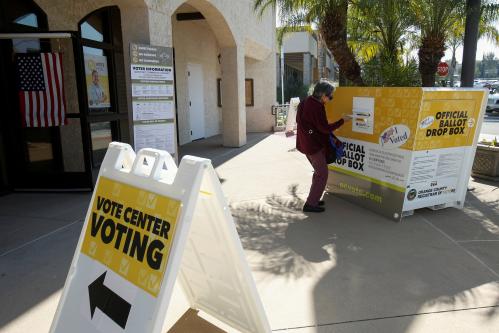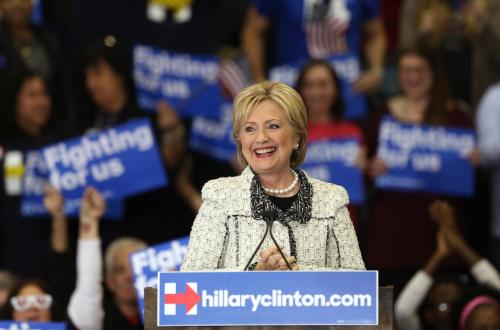Super Tuesday is the day that the race for the presidential nomination gets real, the day where the measure of success changes from winning states to winning delegates. On this year’s Super Tuesday, 14 states will hold primaries and award 1,357 (34 percent) of the delegates to the Democratic convention. For all the attention given to the “pre-season” states Iowa, New Hampshire, Nevada, and South Carolina, they barely account for 4 percent of the delegates to the convention.
Despite their small size the pre-season states have done what they have always done. They have narrowed the field of candidates and conferred something even more important than money on a single presidential candidate—momentum. With three wins behind him and the prospect of a decent showing in South Carolina, Sen. Bernie Sanders has become the candidate to beat. So, here’s what to look for.
The delegate count
Most of the delegates to the convention are awarded by congressional districts (or state senate districts in Texas). What that means is that it is possible to lose a state but still win some of its delegates; the race for the nomination boils down to who can win the most delegates in 435 congressional districts (as happened in Iowa for Mayor Pete Buttigieg). Some candidates, however, are trying to spin this to mean that it is not important to win states. That is an exaggeration. It is virtually impossible to get to the magic number without winning some—several—states.
The better way to understand this is that a winning candidate is one managing to win a significant share of delegates in states even when they are losing the states. For instance, in 2008, Barack Obama was not expected to win Hillary Clinton’s home state of New York and he didn’t. But by carefully targeting districts where he could win, Obama still won 93 pledged delegates to Hillary Clinton’s 139 delegates.
The distance between the candidates
Second, it is important to look at the distance in the delegate count between the first-place finisher and the second-place finisher. If the eventual winner opens up a large margin on Super Tuesday it becomes very difficult for the second-place finisher to close the margin in the remaining contests.
For instance, in 1980 President Carter helped move some southern states to early March. On March 11, three southern states held contests: Alabama, Florida and Georgia. Jimmy Carter won 43 delegates in Alabama and Senator Ted Kennedy, his opponent, won only 2. In Florida Carter beat Kennedy three to one, and in Georgia, Carter won all the delegates and Kennedy won none. Carter went on to have lopsided wins in all 13 southern states, building up a substantial lead over Kennedy which kept him winning the delegate count, even when the primaries moved to northern states and Kennedy began to win.[1]
Thirty-six years later, Hillary Clinton had a nomination victory over Senator Bernie Sanders that was reminiscent of Jimmy Carter’s. She won lopsided victories in every southern state, leading Sanders by 72 delegates in Texas, 68 delegates in Florida, and 44 delegates in Georgia to name but a few. In the early non-southern states that she won, her delegate victories were not nearly as large.[2]
All districts are not created equal
In trying to anticipate the delegate count, it is important to realize that in the Democratic Party, districts electing delegates can get as few as 2 and as many as 10 delegates.[3] That’s because delegates are apportioned within states on the basis of Democratic performance in past elections. So, for instance, in Texas (which uses state senate districts instead of congressional districts), the 14th state senate district has 10 delegates to the national convention. This district encompasses Austin, the most Democratic part of the state. In contrast, the 31st state senate district, stretching from Amarillo to Midland, gets to send only 2 delegates to the Democratic convention. That district is such a Republican stronghold that there hasn’t been a Democrat on the ballot for the state senate seat since 2004, and the incumbent Republican won over 87 percent of the vote in 2018; hence it has very few delegates.
What to watch
- Be patient and wait for the delegate counts. Election results usually come in by county and the experts have to convert counties to districts (usually congressional districts.)
- Look for the distance between the candidates. If three or more are bunched together in the delegate count, they will all probably stay in the race, increasing the odds of no one getting a first ballot nomination at the Democratic Convention in Milwaukee in July. If two candidates emerge in close proximity to each other, there will be plenty of pressure for the losers to get out and pick sides. And if one candidate opens up a sizable lead over all the others, he or she will be hard to stop.
- As more data come in, look at where the candidates are doing well. For instance, if one candidate is winning lopsided victories in heavily Democratic areas, they will probably continue to amass delegates because these districts have more delegates. While winning in Republican areas may be a clue to a candidate’s general election strength, these districts don’t have a lot of delegates.
- Finally, forget the spin. In the early states, spin is possible. But once Super Tuesday happens, it’s all about the numbers.
[1] See table on page 144 in Primary Politics
[2] See table on page 50 in Primary Politics
[3] In the Republican party all districts have the same number of delegates.







Commentary
What to watch on Super Tuesday
February 25, 2020